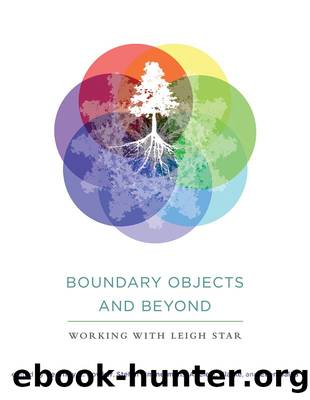Boundary Objects and Beyond: Working with Leigh Star (Infrastructures) by Geoffrey C. Bowker & Stefan Timmermans & Adele E. Clarke & Ellen Balka

Author:Geoffrey C. Bowker & Stefan Timmermans & Adele E. Clarke & Ellen Balka
Language: eng
Format: mobi
ISBN: 9780262029742
Publisher: The MIT Press
Published: 2016-02-26T00:00:00+00:00
Network or Networks: That Is the Question
There is thus a critical difference between stabilization within a network or community of practice, and stabilization between networks, and again critical differences between those for whom networks are stable and those for whom they are not, where those are putatively the “same” network. Again we have a choice for a point of departure: does McDonald’s represent a stable network, a source of chaos, or a third thing altogether?
Politics by Other Means or by the Same Old Means?
Bruno Latour explicates some of the features of actor-network theory, and the mix between humans and nonhumans involved in socio-technical systems, in his article on “The Sociology of a Door.” He advocates an ecological analysis of people and objects, looking at the links between them, the shifts with respect to action, and the ways that duties, morality, and actions are shifted between humans and nonhumans: “The label ‘inhuman’ applied to techniques simply overlooks translation mechanisms and the many choices that exist for figuring or de-figuring, personifying or abstracting, embodying or disembodying actors” (Latour 1988, 303).
The analytic freedom accorded by this heuristic is considerable; in fact Latour and Callon’s work has opened up a whole new way of analyzing technology. However, the problem remains with respect to humans and the question of power that such mixes may seem to sidestep traditional questions of distribution and access: “As a technologist, I could claim that, provided you put aside maintenance and the few sectors of population that are discriminated against, the groom does its job well, closing the door behind you constantly, firmly and slowly” (Latour 1988, 302).
There is no analytic reason to put aside maintenance and the few sectors of population that are discriminated against, in fact, every reason not to. As Latour himself notes in response to criticism of the actor-network theory for the political implications of its “leveling” of human/nonhuman differences, heuristic flattening does not mean the same thing as empirical ignoring of differences in access or experience. Rather, it is a way of breaking down reified boundaries that prevent us from seeing the ways in which humans and machines are intermingled.
However, one of the features of the intermingling that occurs may be that of exclusion (technology as barrier) or violence, as well as of extension and empowerment. I think it is both more analytically interesting and more politically just to begin with the question, cui bono? than to begin with a celebration of the fact of human/nonhuman mingling.
Download
This site does not store any files on its server. We only index and link to content provided by other sites. Please contact the content providers to delete copyright contents if any and email us, we'll remove relevant links or contents immediately.
Cecilia; Or, Memoirs of an Heiress — Volume 1 by Fanny Burney(32434)
Cecilia; Or, Memoirs of an Heiress — Volume 2 by Fanny Burney(31868)
Cecilia; Or, Memoirs of an Heiress — Volume 3 by Fanny Burney(31852)
The Great Music City by Andrea Baker(31327)
We're Going to Need More Wine by Gabrielle Union(18967)
All the Missing Girls by Megan Miranda(15562)
Pimp by Iceberg Slim(14379)
Bombshells: Glamour Girls of a Lifetime by Sullivan Steve(13972)
Talking to Strangers by Malcolm Gladwell(13222)
Norse Mythology by Gaiman Neil(13204)
Fifty Shades Freed by E L James(13157)
For the Love of Europe by Rick Steves(12927)
Mindhunter: Inside the FBI's Elite Serial Crime Unit by John E. Douglas & Mark Olshaker(9186)
Crazy Rich Asians by Kevin Kwan(9167)
The Lost Art of Listening by Michael P. Nichols(7403)
Enlightenment Now: The Case for Reason, Science, Humanism, and Progress by Steven Pinker(7228)
The Four Agreements by Don Miguel Ruiz(6622)
Bad Blood by John Carreyrou(6543)
Weapons of Math Destruction by Cathy O'Neil(6142)
